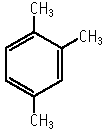

1,2,4-Trimethylbenzene was not mutagenic to Salmonella typhimurium TA100, TA98, TA1535, TA1537 and Escherichia coli WP2 uvrA, with or without an exogeneous metabolic activation system.
1,2,4-Trimethylbenzene induced neither structural chromosomal aberrations nor polyploidsy in CHL/IU cells up to a concentration (0.08-0.15 mg/ml) more than that causing 50% cell growth inhibition, in the absence or presence of an exogenous metabolic activation system.
| Purity | : | 98.75% |
| Test species/strain | : | Rat/Crj:CD (SD) |
| Test method | : | Guidelines for the 28-Day Repeat Dose Toxicity Test of Chemicals (Japan) |
| Route | : | Oral (gavage) |
| Doses | : | 0 (vehicle), 30, 100, 300, 1000 mg/kg/day |
| Number of animals/group | : | Males, 10 or 15 (0 and 1000 mg/kg) Females, 10 or 15 (0 and 1000 mg/kg) |
| Vehicle | : | Corn oil |
| Administration period | : | Males, females; 28 days |
| Terminal kill | : | Males, females; days 29 or 43 (0, 1000 mg/kg) |
| GLP | : | Yes |
Test results:
On hematological and blood chemical examinations, no changes were found for any parameter in either sex of the groups treated with 1,2,4-trimethylbenzene. At necropsy, no abnormalities were found in either sex of any group. For organ weights of the males, increases in the relative kidney weights were noted in the groups treated with 300 mg/kg or more, and increases of the relative liver weights and the absolute kidney weights were observed in the 1000 mg/kg group. For the females, increases in the absolute and relative liver weights were shown in the groups treated with 300 mg/kg or more, and increase in the relative kidney weight was noted for the 1000 mg/kg group. These changes had disappeared by the termination of the recovery period. On histopathological examination of the males, hyaline droplet degeneration of renal tubules had was found in the groups treated with 300 mg/kg or more. This finding had disappeared by the termination of the recovery period. No abnormalities attributable to the test compound administration were found in the females.
The NOEL of 1,2,4-trimethylbenzene by oral administration for 28-days is considered to be 100 mg/kg/day for both sexes.
| Purity | : | 98.75 % |
| Test species/strains | : | Salmonella typhimurium TA100, TA1535, TA98, TA1537, Escherichia coli WP2 uvrA |
| Test methods | : | Guidelines for Screening Mutagenicity Testing of Chemicals (Japan) and OECD (471 and 472) |
| Procedures | : | Plate incorporation method |
| Solvent | : | DMSO |
| Positive controls | : | -S9 mix, 2-(2-Furyl)-3-(5-nitro-2-furyl)acrylamide (TA100, WP2, TA98), Sodium azide (TA1535)and 9-Aminoacridine (TA1537)
+S9 mix, 2-Aminoanthracene (five strains) |
| Doses | : | -S9 mix, 0, 7.81, 15.6, 31.3, 62.5, 125 and 250 μg/plate (TA100, TA1535, TA98 and TA1537), 0, 15.6 - 500 μg/plate (WP2)
+S9 mix, 0, 7.81 - 250 μg/plate (TA1537), 0, 15.6 - 500 μg/plate (TA100, TA1535 and WP2), 0, 31.3 - 1000 μg/plate (TA98) |
| S9 | : | Rat liver, induced with phenobarbital and 5,6-benzoflavone |
| Plates/test | : | 3 |
| Number of replicates | : | 2 |
| GLP | : | Yes |
Genetic effects:
Salmonella typhimurium TA100, TA1535, TA98, TA1537
| + | ? | - | |
| Without metabolic activation: | [ ] | [ ] | [*] |
| With metabolic activation: | [ ] | [ ] | [*] |
Escherichia coli WP2 uvrA
| + | ? | - | |
| Without metabolic activation: | [ ] | [ ] | [*] |
| With metabolic activation: | [ ] | [ ] | [*] |
| Purity | : | 98.75% |
| Type of cell used | : | Chinese hamster lung (CHL/IU) cells |
| Test method | : | Guidelines for Screening Mutagenicity Testing of Chemicals (Japan) |
| Solvent | : | Dimethylsulfoxide |
| Positive controls | : | -S9 mix, Mitomycin C
+S9 mix, Cyclophosphamide |
| Doses | : | -S9 mix (continuous treatment): 0, 0.020, 0.040,0.080 mg/ml
-S9 mix (short-term treatment): 0, 0.038, 0.075,0.15 mg/ml +S9 mix (short-term treatment): 0, 0.025, 0.050.0.10 mg/ml |
| S-9 | : | Rat liver, induced with phenobarbital and 5,6-benzoflavone |
| Plates/test | : | 2 |
| GLP | : | Yes |
| clastogenicity | polyploidy | |||||
| + | ? | - | + | ? | - | |
| Without metabolic activation: | [ ] | [ ] | [*] | [ ] | [ ] | [*] |
| With metabolic activation: | [ ] | [ ] | [*] | [ ] | [ ] | [*] |
| 1) | The test was performed by Nihon Bioresearch Inc. Hashima Laboratory, 6-104 Majima, Fukuju-cho, Hashima, Gifu, 501-62 Japan Tel +81-58-392-6222 Fax +81-58-391-3171 |
| 2) | The tests were performed by the Hatano Research Institute, Food and Drug Safety Center, 729-5 Ochiai, Hadano-shi, Kanagawa, 257, Japan. Tel +81-463-82-4751 Fax +81-463-82-9627 |